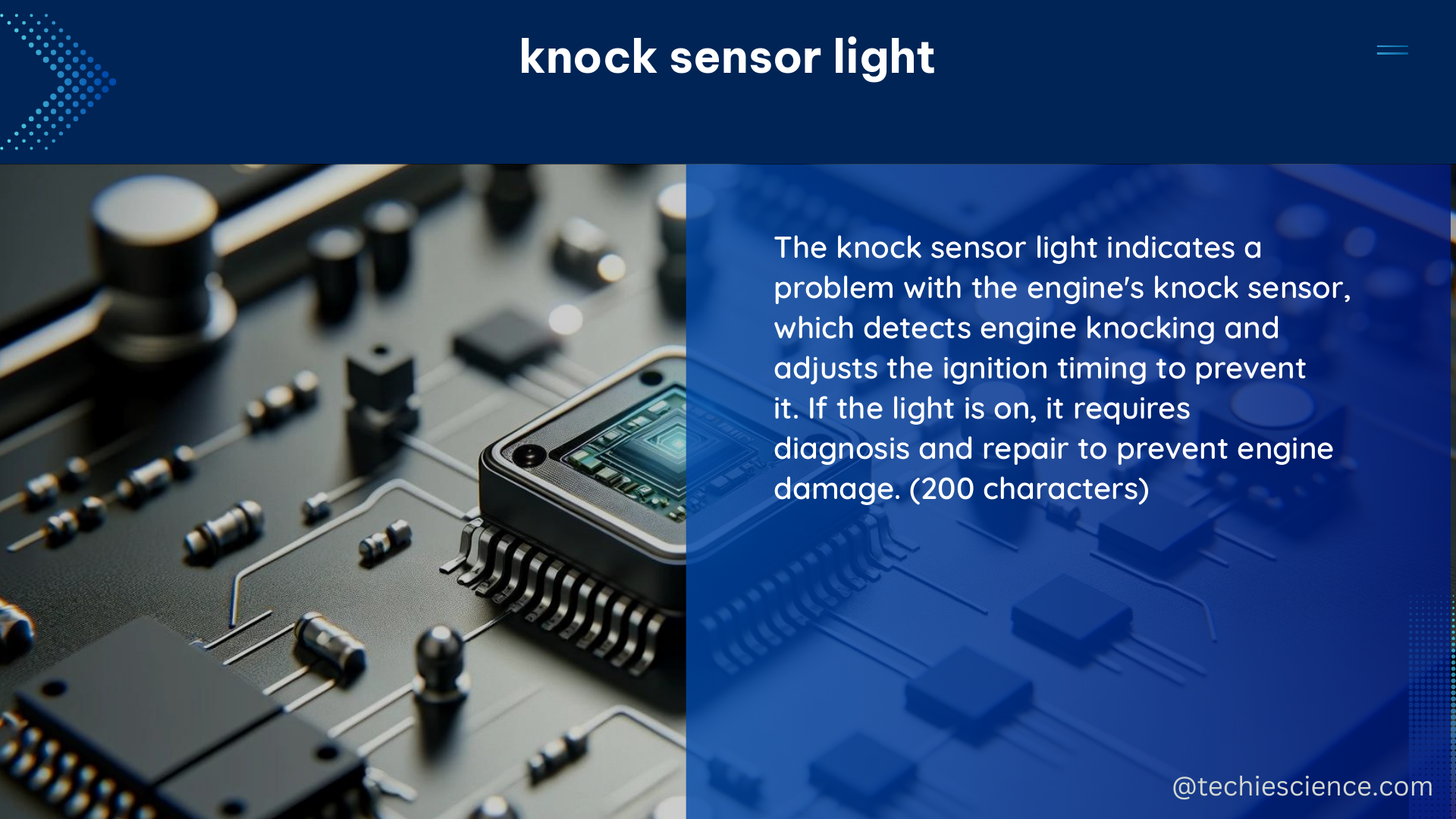The knock sensor is a critical component in modern internal combustion engines, responsible for detecting engine knocking or pinging, which can lead to severe engine damage if left unaddressed. The knock sensor light, typically labeled as the “Check Engine” light, illuminates when the engine control unit (ECU) detects a problem with the knock sensor or other related engine components.
Technical Specifications of Knock Sensor Light
-
Component Location: The knock sensor is usually mounted in the engine block or cylinder head, near the spark plugs. The sensor is strategically positioned to accurately detect vibrations caused by engine knocking.
-
Signal Detection: The knock sensor utilizes a piezoelectric crystal that generates an electrical signal in response to the vibrations caused by engine knocking. This electrical signal is then sent to the ECU for analysis.
-
Sensor Sensitivity: Knock sensors are designed with a specific sensitivity range to accurately detect the onset of engine knocking. The sensor’s sensitivity is typically measured in millivolts per g-force (mV/g), with higher sensitivity sensors providing more precise knock detection.
-
Functionality: The ECU continuously monitors the knock sensor’s signal and adjusts the ignition timing and fuel injection parameters to prevent engine knocking. This process ensures optimal engine performance and longevity by avoiding the damaging effects of engine knock.
-
Trouble Code Detection: When the knock sensor light illuminates, the ECU stores a diagnostic trouble code (DTC) related to the knock sensor or other affected components. These DTCs can be retrieved using an OBD-II scan tool, providing valuable information for diagnosis and troubleshooting.
Knock Sensor Light Diagnosis and Troubleshooting

To diagnose and potentially resolve a knock sensor light issue, follow these comprehensive steps:
- Retrieve the DTC:
- Use an OBD-II scan tool to retrieve the stored DTC related to the knock sensor light.
-
Common DTCs include P0325 (Knock Sensor Circuit Malfunction) and P0326 (Knock Sensor Circuit Range/Performance).
-
Inspect the Knock Sensor:
- Visually inspect the knock sensor for signs of damage, corrosion, or loose connections.
- Ensure the sensor is securely mounted and properly connected to the engine and wiring harness.
-
Check the sensor’s mounting location to ensure it is positioned correctly and not obstructed by other engine components.
-
Test the Knock Sensor:
- Use a multimeter to measure the resistance of the knock sensor, comparing the readings to the manufacturer’s specifications.
- A faulty sensor may exhibit high or low resistance values, indicating a problem with the sensor’s internal components.
-
Some knock sensors may also require a voltage or signal test to verify their proper operation.
-
Check the Wiring and Connectors:
- Inspect the wiring and connectors leading to the knock sensor for damage, corrosion, or loose connections.
- Repair or replace any damaged components as necessary, ensuring a secure and reliable electrical connection.
-
Verify the wiring harness is properly shielded to prevent electromagnetic interference (EMI), which can disrupt the sensor’s signal.
-
Clear the DTC:
- Once the issue has been resolved, use the scan tool to clear the stored DTC.
- Perform a test drive to ensure the knock sensor light remains off and the engine operates normally.
Advanced Troubleshooting Techniques
In some cases, more advanced troubleshooting may be required to diagnose and resolve a persistent knock sensor light issue. Consider the following additional steps:
- Sensor Replacement:
- If the knock sensor tests indicate a faulty component, replace the sensor with a new one that meets the manufacturer’s specifications.
-
Ensure the replacement sensor is properly installed and torqued to the recommended specifications.
-
ECU Diagnosis:
- If the knock sensor and wiring appear to be functioning correctly, the issue may be related to the ECU’s knock detection algorithm or programming.
-
In such cases, consult the vehicle’s service manual or contact the manufacturer for guidance on ECU diagnosis and potential reprogramming.
-
Engine Condition Assessment:
- In rare cases, the knock sensor light may illuminate due to underlying engine issues, such as carbon buildup, worn piston rings, or other mechanical problems.
-
Perform a comprehensive engine inspection and diagnostic tests to rule out any underlying engine-related causes.
-
Sensor Calibration:
- Some vehicles may require the knock sensor to be calibrated or “learned” by the ECU after replacement or repair.
- Follow the manufacturer’s recommended procedures for sensor calibration to ensure proper integration with the engine control system.
By following these comprehensive steps and utilizing advanced troubleshooting techniques, you can effectively diagnose and resolve knock sensor light issues, ensuring your vehicle’s engine operates at peak performance and longevity.
References:
- Reddit – Robots With Flawed AI Make Sexist And Racist Decisions
- Air Force – Administrative Changes to AETC TTP11-1, Employment
- HELLA – Check and change ABS sensor
- Owens Corning – 2021 Sustainability Report
- MyGolfSpy – L.A.B. Putters – 2023 Forum Review

The lambdageeks.com Core SME Team is a group of experienced subject matter experts from diverse scientific and technical fields including Physics, Chemistry, Technology,Electronics & Electrical Engineering, Automotive, Mechanical Engineering. Our team collaborates to create high-quality, well-researched articles on a wide range of science and technology topics for the lambdageeks.com website.
All Our Senior SME are having more than 7 Years of experience in the respective fields . They are either Working Industry Professionals or assocaited With different Universities. Refer Our Authors Page to get to know About our Core SMEs.